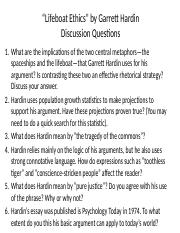
I also propose that international aid is possible with overpopulation amelioration, especially when conducted by third party and non-profit agencies. Although very few countries have surplus capacity, or are under capacity. My response to this potential counterargument has two parts: on one hand, the stability of Hardinian bipolarity is established upon the Rational Actor Model wherein theoretical utility-maximization does not guarantee stability in reality especially under the influence of contingent factors on the other hand, even if Hardinian bipolarity guarantees stability of societal systems, Lifeboat Ethics does not possess strong theoretical strength to give practical moral guidance. As human population grows, it begins to exceed the Earths carrying capacity. My opponents may propose that population reduction gives rise to a Hardinian bipolar world that eventually stabilizes itself. We will write a custom Critical Writing on Metaphor in Lifeboat Ethics by Garrett Hardin specifically for you. In response, I argue that Hardin’s solution to the “Tragedy of Commons” denotes perpetual population reduction, which inevitably entails systematic instability that diminishes people’s welfare. The ethical dilemma of lifeboat circumstances is the ability of the law enforcement agencies to produce abusive practices towards the migrants that best represents a lifeboat ethics. The co-existence of these mutually opposing concepts and forces is necessary for the balancing effect of the universe. Yet the absence of supreme coercive authority to enforce fair sharing gives ample incentive for rule violation, as states attempt to maximize self-interest in disregard for the eventual collective ruin, which Hardin refers to as the “Tragedy of Commons.” Since other states act both as sharers and opponents, a state should aggressively eradicate them to ensure its survival. Composition and Critical Thinking Course Reader: War and Peace. The global resources are finite and states ideally should share it equally for maximum collective interest. Lifeboat Ethics: The Case Against Helping the Poor.

This helps readers follow the article without boredom or confusion.A utilitarian, Garrett Hardin in his Lifeboat Ethics argues that an international state should refrain from sharing resources with and providing help for other states to maximize its people’s welfare. All ethic beliefs have flaws and strong points, as you will see in the following explanations. It goes that the lifeboat is the wealth nations and the people in the water are the poor or unfortunate. He uses subtopics to offer specific explanations in the article and create emphasis on specific topics. Lifeboat ethics, or the lifeboat problem, is the moral dilemma created by imagining the following situation. Adrift in the Ocean of Philosophy This is the scenario of the Lifeboat Ethics in which Hardin relates this lifeboat to the space ship Earth. The people inside the lifeboats are doubling in numbers every 87 years those swimming around outside are doubling, on the average, every 35 years, more than twice as fast as the rich. In addition to this, he asks if it is necessary for the rich nations to offer help, and to what extent, and how the poor nations view this help. The harsh ethics of the lifeboat become even harsher when we consider the reproductive differences between the rich nations and the poor nations. Das Gupta, Monica Off of Sr VP Dev Econ/Chief. His main aim is to establish the “helping” relationship between poor and rich nations, and the morals attached to this help. In Garrett Hardin’s paper, Lifeboat Ethics: The Case against Helping the Poor, Harden uses the analogy of a lifeboat being a nation. Lifeboat ethics versus corporate ethics - social and demographic implications of stem and joint families. He says that guilt drives some people into helping others, while some people, who ask for help, do not feel guilty for needing this help. This illustration makes it easy for readers to relate to his arguments.


For example, he uses the metaphor of spaceship situation (a drift in a moral sea), where admitting or not admitting more people into a spaceship might exceed its capacity. In the humanitarian and Christian world, it is selfish not to help anyone who needs your help however, where do we draw the philanthropic line? He uses illustrations to explain his arguments. The author of this article seeks to rationalize the act of helping the poor or those in need.


 0 kommentar(er)
0 kommentar(er)
